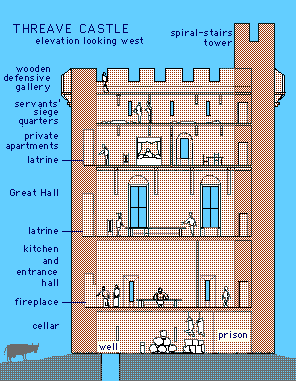History


Threave Castle
The Stewartry
Dumfries and Galloway
Southern Scotland

The castle is on an island in the middle of the River Dee; even getting to it is an exciting and romantic experience in itself.
From Kelton Mains farm there is a ten minute walk through fields and past woods until you arrive at the shore of the River Dee.
There you will find a small jetty and a brass bell with a rope pull. Ring this bell loudly and the boatman will come across from the island to take you to the castle.
A Stronghold of the Black Douglases
Threave Island may have been the home of the ancient rulers of Galloway, but today's castle was built at the end of the 1300's by the powerful Archibald Douglas, known as "Archibald the Grim"
Archibald's father, Sir James Douglas, "The Good", had been entrusted with taking Robert the Bruce's heart to the Jerusalem, but had been killed in Spain fighting the Moors (and Bruce's heart was brought back to Scotland and buried at Melrose Abbey). He also put down the rebellious Gallovidian chiefs when they had sided with the English. His cousin, William Douglas did the same in 1353.
Because of these services to Scotland Robert the Bruce's son, King David II, bestowed an Earldom on the Douglas family, and the heart became the principal emblem of the Black Douglas. Threave became Archibald's stronghold in his new position as Third Earl of Douglas, Lord of Galloway and Warden of the West March (ie; West Border).
 Archibald died at Threave in 1400. He was succeeded by his son, also Archibald, who married Princess Margaret, the daughter of Robert III. Her husband was killed at the Battle of Verneuil while fighting for the French against the English in 1424. She herself died in 1450 was buried in Lincludden Collegiate Church near Dumfries.
Archibald died at Threave in 1400. He was succeeded by his son, also Archibald, who married Princess Margaret, the daughter of Robert III. Her husband was killed at the Battle of Verneuil while fighting for the French against the English in 1424. She herself died in 1450 was buried in Lincludden Collegiate Church near Dumfries.
King James II was only 6 when he was crowned in 1437. Archibald, 5th Earl of Douglas, was appointed Regent. When he died two years later, two men, Sir Alexander Livingstone and Sir William Crichton fought to take the place of the Douglases.
They invited the new Earl of Douglas, then only 16 years old, to dine with his brother and a friend at Edinburgh Castle. At the end of the meal the head of a black bull was brought to the table, and at this sign all three were murdered.


James resented the power of the Douglases. In 1452 he invited William, the 8th Earl, to Stirling under safe-conduct to negotiate their relationship. During the meeting the 21 year old James drew his dagger and stabbed him. His courtiers joined in and William was dead.
Immediately the 9th Earl sprang to arms proclaiming the King a murderer and outlaw. James's Parliament replied by stating that; "the Earl was guilty of his own death by resisting the King's gentle persuasion".
Right; This is a drawing of how the interior would have been at the time of the Douglases.
The walls of the Great Hall and Private Apartments would have been plastered and hung with fabrics and tapestries.
Large windows facing over the River Dee would have let in a good light.
The Douglases were defeated at Arkinholm near Langholm and the 9th Earl was exiled. James began the systematic destruction all the Douglas strongholds, culminating in a two month siege of Threave Castle in the summer of 1455.
James attended the siege in person. Although his main residence was at nearby Tongland Abbey, he had a field-tent erected at Threave. But in spite of heavy bombardment, including shots from a great "Bombard", a massive siege gun, the castle held out and only surrendered after the garrison commanders had been promised various payments and promises of safe conduct.
Sir Alexander Boyd of Drumcoll was put in charge, and the castle remained annexed to the crown until it was granted to Lord Maxwell of Caerlaverock Castle until it was abandoned in 1640. At this time an earth bank was put up as an outer gun emplacement probably in readiness for the siege by the Covenanters. Again the siege failed to take Threave by force, but nonetheless eventually the castle surrendered and was subsequently "slighted", ie; made uninhabitable.

Today the castle is very evocative of those turbulent times four or five hundred years ago. The surrounding landscape of boggy marsh, water, and woodlands has probably not changed much, although the height of the river is slightly lower so that the island is now bigger. In winter it is almost inaccessible.
Threave Castle is under the care of Historic Scotland and is open to the public during the summer.
It is about 1 mile west of Castle Douglas, Kirkcudbrightshire, S.W.Scotland.
Today the castle is very evocative of those turbulent times four or five hundred years ago. The surrounding landscape of boggy marsh, water, and woodlands has probably not changed much, although the height of the river is slightly lower so that the island is now bigger. In winter it is almost inaccessible.
Please enquire about opening times before visiting: Tel: 01831 168512
Related pages:
- Caerlaverock Castle
- Crichton Castle
- The mystery of the heart of Robert the Bruce
